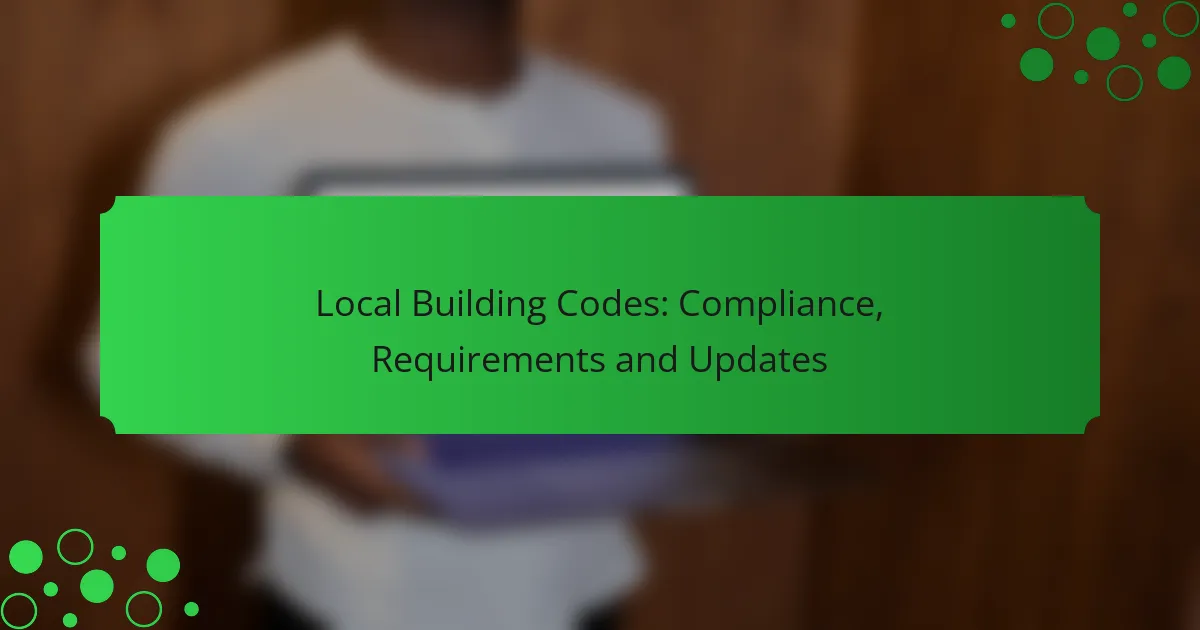Local building codes are essential regulations that dictate construction standards, safety measures, and design practices within a specific area. They play a crucial role in ensuring that buildings are safe, accessible, and environmentally sustainable, while also reflecting both state and local requirements. To comply with these codes, it is important to understand the specific regulations in your locality and to work with qualified professionals throughout the construction process.

What are the local building codes in California?
Local building codes in California are regulations that govern construction standards, safety, and design practices within the state. These codes ensure that buildings are safe, accessible, and environmentally sustainable, reflecting both state and local requirements.
California Building Code (CBC)
The California Building Code (CBC) serves as the foundational set of regulations for construction across the state. It is updated every three years and incorporates provisions from the International Building Code while addressing specific California needs, such as seismic safety and energy efficiency.
Key aspects of the CBC include structural integrity, fire safety, accessibility, and energy conservation. Builders must ensure compliance with these codes during the design and construction phases to avoid costly penalties and ensure public safety.
Local amendments by city
Many cities in California adopt local amendments to the CBC to address unique environmental, cultural, or community needs. These amendments can vary significantly, affecting everything from zoning laws to specific construction materials allowed.
For instance, cities like San Francisco may have stricter regulations concerning historic preservation, while Los Angeles might focus on energy efficiency standards. It’s essential for builders and homeowners to check with their local planning department to understand the specific amendments applicable to their projects.

How to ensure compliance with local building codes?
To ensure compliance with local building codes, familiarize yourself with the specific regulations in your area and follow the necessary procedures. This involves obtaining the right permits and working with qualified professionals to meet all safety and structural standards.
Obtain necessary permits
Obtaining the necessary permits is a crucial step in ensuring compliance with local building codes. Before starting any construction or renovation project, check with your local building department to identify which permits are required. This may include zoning permits, building permits, and inspections at various stages of the project.
Failure to secure the appropriate permits can lead to fines, project delays, or even the need to dismantle completed work. Always keep records of your permits and any correspondence with local authorities to avoid complications.
Consult with licensed contractors
Consulting with licensed contractors is essential for navigating local building codes effectively. Licensed professionals are familiar with the regulations and can help ensure that your project meets all compliance requirements. They can also provide insights into best practices and potential pitfalls.
When selecting a contractor, verify their credentials and experience with similar projects in your area. Ask for references and check reviews to ensure they have a solid track record of compliance and quality work. This collaboration can save you time and money while minimizing the risk of code violations.

What are the common requirements for residential construction?
Common requirements for residential construction include adherence to local building codes, which govern aspects like setback regulations and height restrictions. These codes ensure safety, functionality, and aesthetic harmony within communities.
Setback regulations
Setback regulations dictate how far a building must be from property lines, streets, or other structures. These distances vary by locality and can range from a few feet to several meters, depending on zoning laws and the type of building.
When planning a residential project, check local ordinances to determine specific setback requirements. Failure to comply can result in fines or the need to modify or demolish non-compliant structures.
Height restrictions
Height restrictions limit how tall a building can be, often influenced by zoning laws and neighborhood character. These limits can vary significantly, with some areas allowing multi-story homes while others may restrict buildings to a single level.
Before beginning construction, verify the maximum allowable height for your project. Consider the implications of height on local views, sunlight access, and overall neighborhood aesthetics, as exceeding these limits can lead to legal challenges or costly adjustments.

How often are local building codes updated?
Local building codes are typically updated on a regular basis, often annually or in response to significant events. These updates ensure that regulations reflect current safety standards, technological advancements, and community needs.
Annual updates
Many municipalities conduct annual reviews of their building codes to incorporate new safety standards and construction practices. These updates may include revisions to energy efficiency requirements, structural integrity guidelines, and accessibility standards.
For example, a city might revise its codes to align with the latest International Building Code (IBC) standards, which can vary based on local climate and building practices. Builders should stay informed about these annual changes to ensure compliance and avoid potential fines.
Significant changes after major events
Local building codes may undergo significant changes following major events such as natural disasters, fires, or significant infrastructure failures. These updates aim to enhance safety and resilience against similar future incidents.
For instance, after a severe earthquake, a region may implement stricter seismic design requirements to protect buildings and occupants. Stakeholders, including builders and homeowners, should monitor these changes closely, as they can affect construction timelines and costs.

What are the penalties for non-compliance?
Penalties for non-compliance with local building codes can include fines, fees, and potential legal actions. These consequences vary by jurisdiction and the severity of the violation, making it crucial for builders and property owners to understand their obligations.
Fines and fees
Fines for non-compliance can range from a few hundred to several thousand dollars, depending on the nature of the violation. Local governments often impose these fines to encourage adherence to safety and construction standards.
In addition to fines, there may be administrative fees associated with the processing of violations or the need for re-inspections. It’s advisable to check with local authorities for specific fee structures and potential discounts for prompt compliance.
Potential legal action
In severe cases of non-compliance, local authorities may pursue legal action against the property owner or builder. This can result in court orders to rectify violations, which may involve significant costs and delays.
Legal actions can also lead to liabilities for damages if non-compliance results in injuries or property damage. It’s essential to address any compliance issues promptly to avoid escalating legal consequences.

How to find local building code resources?
To find local building code resources, start by checking your city or county’s official website, as they often provide comprehensive information on codes and regulations. Additionally, state resources can offer broader guidelines that apply across multiple municipalities.
City planning department websites
City planning department websites are essential for accessing local building codes. These sites typically include zoning laws, permit requirements, and specific construction regulations that apply within the city limits. For example, a city like San Francisco may have unique regulations regarding historical buildings that differ from those in nearby Oakland.
When visiting these websites, look for sections dedicated to building permits or construction guidelines. Many cities also offer downloadable documents or interactive tools to help you understand compliance requirements. Always ensure you are referencing the most current information, as codes can change frequently.
State building code resources
State building code resources provide a broader context for construction regulations that apply throughout the state. These resources often include the state’s adopted building codes, amendments, and enforcement procedures. For instance, the Florida Building Code outlines standards for hurricane-resistant construction that are crucial for coastal areas.
To access these resources, visit your state’s official government website, typically under the department of housing or construction. Many states also offer online databases where you can search for specific codes and regulations by category or keyword. Familiarize yourself with these resources to ensure compliance with both state and local requirements.

What are the differences between residential and commercial building codes?
Residential building codes primarily focus on the safety and livability of homes, while commercial building codes address the needs of businesses and public spaces. Each set of codes includes specific requirements that reflect the different uses and occupancy types of the buildings.
Occupancy classifications
Occupancy classifications categorize buildings based on their intended use, which influences the applicable building codes. For instance, residential buildings typically fall under classifications like single-family homes or multi-family dwellings, while commercial buildings may include offices, retail spaces, or assembly areas.
Understanding these classifications is crucial for compliance, as each type has distinct requirements. For example, a restaurant must adhere to different codes regarding kitchen ventilation and fire safety compared to an office building.
Safety regulations
Safety regulations in building codes ensure the protection of occupants and the public. Residential codes often emphasize structural integrity, fire safety, and accessibility, whereas commercial codes may include additional requirements for emergency exits, occupancy limits, and health standards.
For example, commercial buildings are generally required to have more extensive fire suppression systems and emergency lighting compared to residential properties. Familiarizing yourself with these regulations can help avoid costly compliance issues during construction or renovation.

How do local building codes impact home renovations?
Local building codes significantly influence home renovations by establishing safety, structural integrity, and aesthetic standards. Compliance with these codes ensures that renovations meet legal requirements, which can affect everything from design choices to the overall cost of the project.
Understanding Local Building Codes
Local building codes are regulations set by municipalities that dictate how buildings must be constructed or renovated. These codes cover various aspects, including safety standards, zoning laws, and energy efficiency requirements. Understanding these codes is crucial for homeowners planning renovations to avoid legal issues and ensure project success.
Key Requirements for Compliance
Compliance with local building codes typically involves obtaining permits before starting any renovation work. Homeowners should check with their local building department to understand specific requirements, which may include inspections during different construction phases. Failing to comply can result in fines or the need to undo completed work.
Common Renovation Scenarios
Renovation scenarios such as adding a room, updating electrical systems, or changing plumbing layouts often trigger specific code requirements. For instance, adding a new bathroom may require compliance with plumbing codes and local zoning laws. Homeowners should consult with professionals to navigate these complexities effectively.
Staying Updated on Code Changes
Building codes can change frequently, reflecting new safety standards or technological advancements. Homeowners should stay informed about updates by regularly checking their local building department’s website or subscribing to relevant newsletters. Being proactive can help avoid costly mistakes and ensure that renovations meet current standards.
